|

|
|
Regional Vertical Circulation Lesson
Introductory-level Lesson. The focus of this exercise is regional circulation of water within a groundwater basin - a defined volume of the subsurface through which groundwater flows from areas where the water table is recharged to a location where groundwater discharge occurs. This movement is a three-dimensional phenomenon, but we will use two-dimensional (vertical cross section) flow net diagrams to effectively illustrate some generalized flow system features and the effects of heterogeneity and anisotropy
(Profile Modeling- 6)
|
|

|
|
Groundwater Flow into Tunnels
There is probably no engineering project that requires a more compatible marriage between hydrogeology and engineering than the construction of a tunnel.
The prediction of groundwater inflow into a tunnel is important for designing the tunnel drainage system and to minimize environmental impacts and the risk of tunnel instabilities and subsidence damage. Use MAGNET to simulate the groundwater flow into the given tunnel configurations.
(Profile Modeling- 6)
|
|

|
|
Regional Vertical Circulation 1
Decades of groundwater hydrology research and modeling has demonstrated that flow in the subsurface environment is complex. It consists of shallow and deep flow systems; it is multiscale - a hierarchical system or system of systems. Watch the related videos, answer short questions, and re-create the animations/models using MAGNET.
(Profile Modeling- 6)
|
|
|
|